Vocabulary is a powerful part of the reading experience. And an extremely necessary one.
As we all know, two students can read the same text, and walk away with vastly different levels of understanding, simply because of their familiarity with the vocabulary used in the text! So, the importance of vocabulary work in our teaching can not be overstated. We need to constantly be thinking about how we can improve and grow our students vocabulary.
Of course, we can’t possibly teach our students every unfamiliar word in the world. They will come across words they do not know in their independent reading, and for years after they leave our classrooms. So how do we support our students in vocabulary growth, without teaching them each word? We develop a routine for teaching context clues!
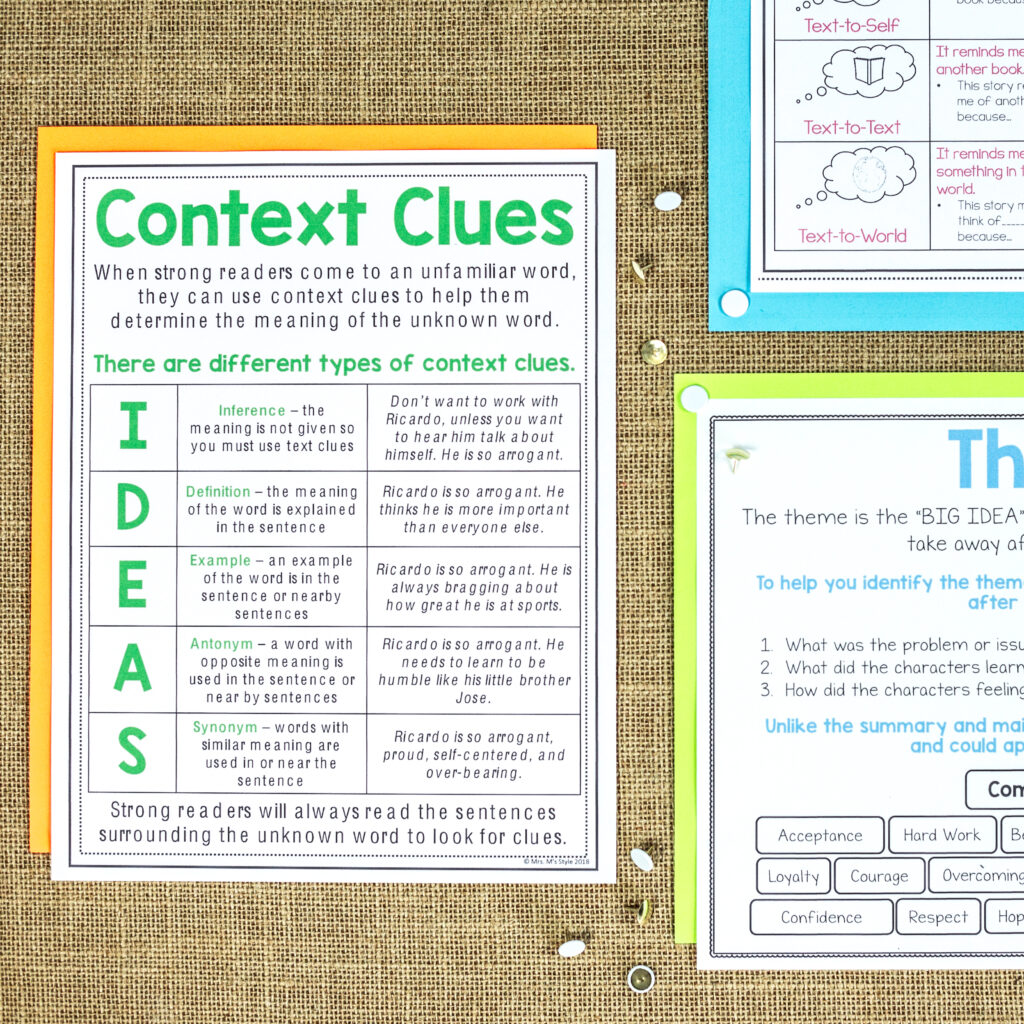
What are context clues?
Context clues are the parts of the text the author includes to give hints about what words may means. Often times when we are teaching context clues we will tell our students that if they come across an unknown word then they can look for clues in the words, sentences, and other paragraphs to help them figure out the meaning of the unknown word…. but what exactly should they be looking for?
If you are going to be teaching context clues to your students, it’s extremely important that you teach your students the five main types of context clues:
- Inference – The meaning is not given so you must use text clues to infer what the unknown word means.
- Definition – The author will include the actual definition of the word. Look at the sentence after the unknown word to see if the author explains what the word means.
- Example – There might be an example of what the unknown word looks like in action. Do the sentences before or after give you an example?
- Antonym – Sometimes we can figure out unknown words because the author will provide the antonym nearby.
- Synonym – You might be able to figure out the unknown word by looking for synonyms. Are there other words that are listed that are similar to the unknown word?
When students know what clues to look for, rather than just re-reading and guessing when they come across an unknown word, they have tools that will help them be successful with context clues.
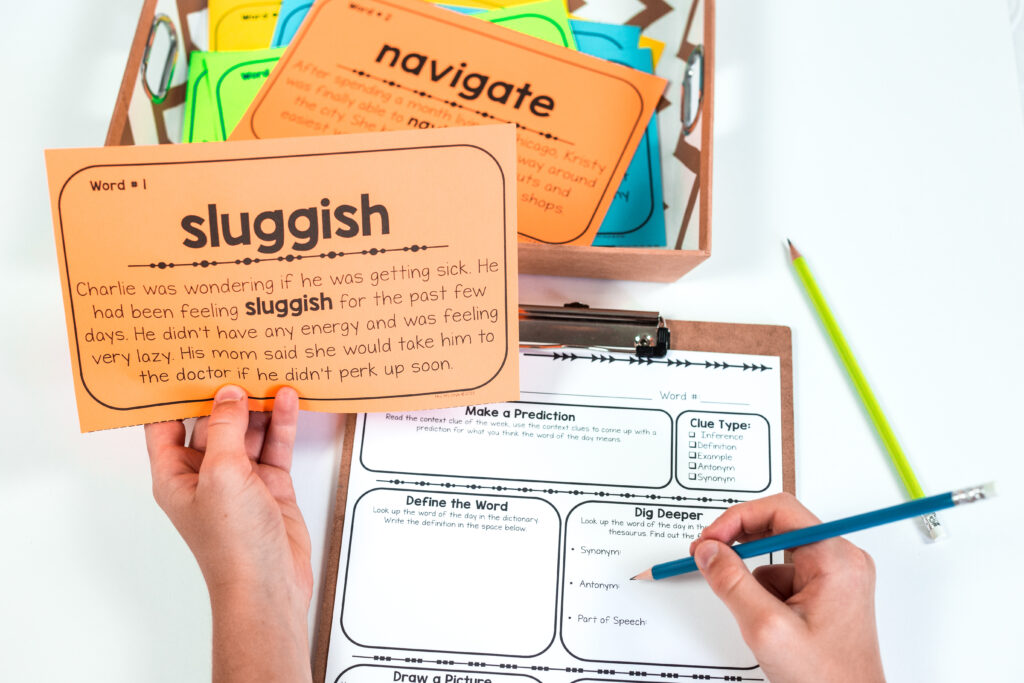
A Step-by-Step Routine for Teaching Context Clues
The way to grow our students in any reading skill is to practice often! So rather than teaching context clues in an isolated lesson or two, I suggest establishing a regular routine for practicing context clues. A weekly routine will help students cement the steps they need to determine meaning of new words when they are reading on their own.
So in my class when I was teaching context clues, we would do what I referred to as our “Word of the Week” Routine. This routine gave us a daily opportunity to not only practice using context clues but really dig deep into the meaning of the word and learn things like how to use a dictionary and thesaurus and discuss the connection words have within the sentences they are a part of.
This five step word of the week routine was perfect for our typical school week – each day we would do a different step in our word of the week routine.
Monday: Identify the unknown or new word.
So step 1 of the routine is to identify the new or unknown word. This routine is something you could do with ANY text. You could pull a word from a shared read aloud, your science or social studies text, or an article your students have read.
When I was in the classroom I had created a resource that included a short paragraph that had a tier 2 vocabulary word that I thought would be new or slightly unfamiliar to my students. It might be something like sluggish, obsolete, or spurt – something that maybe they have read, but really don’t feel confident in their decision.
When we were doing our Word of the Week routine:
- I would display a short paragraph with the word bolded and my students would read the paragraph.
- They would make a prediction on what they think the bolded word was.
- We would discuss their predictions. I wanted students to share the type of clue that they used to figure out the unknown word.
Read the text.
Identify the unknown word.
Make a prediction.
Step one typically takes 5-7 minutes.
Tuesday: Use dictionary to confirm prediction.
I liked to teach my students how to use both an online dictionary and a paper dictionary. I think it’s important for them to know how to use guide words and look up words in an actual book, but also since so many of our students have immediate access to technology I like to teach them how to search the internet for the meaning of a word.
Students would write down the actual definition of the word on our word of the week recording form (which is included in this resource).
If we were doing this routine whole group then I would usually have one student report their definition to the whole group or we would look up the definition and display it on our smart board.
Step two typically takes 2-3 minutes.
Wednesday: Dig deeper into the word of the week.
Ok so this might be my favorite day, and the most important step in teaching context clues.
Helping our students build their vocabularies is more than just having them guess the meaning of an unknown word and then looking it up in the dictionary. We want them to really understand the word and the connection it has to the rest of the words in the sentence.
So the third step in the routine is to dig deep into the word. On this day you can have students use a thesaurus to look up synonyms and antonyms for the word. This will help them make connections to other words they might have a stronger understanding of.
In addition, I also have my students look for and identify the part of speech of the unknown word in the dictionary (or thesaurus). We regularly want to talk about the role each word plays in a sentence and helping students understand that adjectives and verbs behave very differently will help empower them the next time they come across an unknown word.
Step three typically takes 4-5 minutes.
Thursday: Create an Illustration for the word.
I like to have students create a visual AFTER they have looked up synonyms or antonyms for the word because often times students will use what they learned in step 3 (digging deeper) to help them create their visual illustration or symbol.
Step four can take awhile if you let it, but I typically give students just 3-5 minutes and a small amount of space (like smaller than a post-it). When we first start this routine we do talk about how the illustration is not meant to be a work of art, but a quick sketch to help them create an image they can mentally connect the word to.
Friday: Use the word in a sentence.
Step five typically takes 3-4 minutes.
Getting Started with the Routine
If this routine sounds like it is something that will help you when it comes to teaching context clues, then I have a few more tips I want to share with you.
- When you are first introducing this routine to your students, I suggest doing it ALL whole group. I typically model the routine for 2-3 weeks before I let students do it independently. It also might take a little bit longer to go through when you’re modeling because you’re basically training your students how to do this routine on their own.
- After 2-3 weeks of teaching context clues whole group, then I start to let my students do it independently. Because the routine is so repetitive it is a great routine to incorporate into your morning routine or into your literacy centers – or any time of day that you need your students to be independent.
- Towards the end of the first quarter, students typically can do this routine pretty quickly and rather than spreading it out over an entire week, we shift it to Word of the Day and students will do all five steps in one single day.
This shift allows us to use the other days to dig into Greek and Latin Roots, figurative language, prefixes and suffixes, and other vocabulary related concepts that are really important in upper elementary.
Ok, I hope you are getting more and more excited about teaching context clues… and now you have some tools that will help your students do more than just re-read a text and make a guess.
If you want to try this five day routine in your classroom, I have a free sample you can grab below. If you end up loving it, you can get an entire year’s worth of our Word of the Week Routine over in my TPT store. I hope that ends up being a routine that you and your students love using for the entire year.
Happy Teaching!
Grab Your FREE Gift!
Word Of The Day: Context Clue Routine
With this freebie, you’ll get everything you need to get started with word of the day in your classroom. You’ll get all the student and teacher materials for five days. Word of the day will help your students become experts at using context clues.
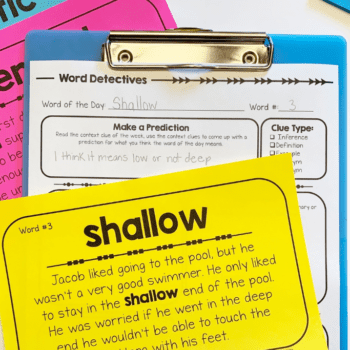


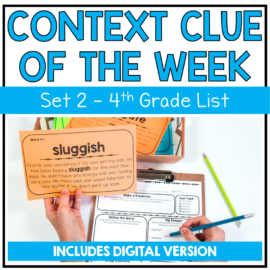
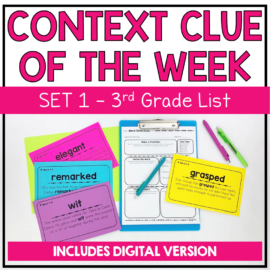
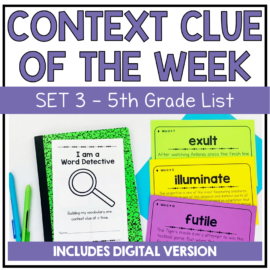
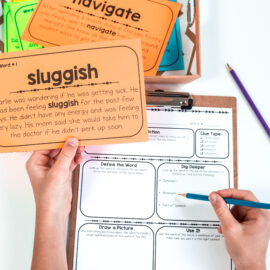

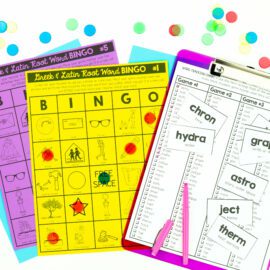









Leave a Comment
You must be logged in to post a comment.